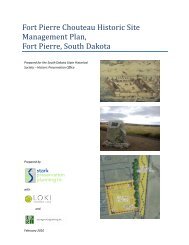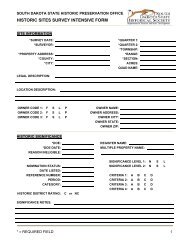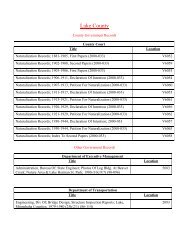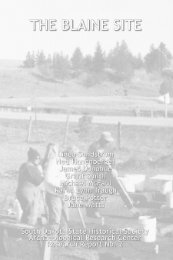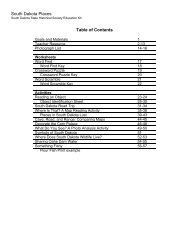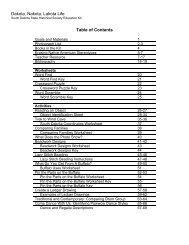A Geoarchaeological Overview of South Dakota and Preliminary
A Geoarchaeological Overview of South Dakota and Preliminary
A Geoarchaeological Overview of South Dakota and Preliminary
You also want an ePaper? Increase the reach of your titles
YUMPU automatically turns print PDFs into web optimized ePapers that Google loves.
DRAFT DRAFT DRAFT<br />
Cheyenne; 39HK34, apparently buried in clayey, Pierre-Shale-derived colluvium, <strong>and</strong> contained in a<br />
slump block detached from the edge <strong>of</strong> a high terrace overlooking the Cheyenne River; <strong>and</strong> 39HK45, a<br />
paleontological site comprised <strong>of</strong> bison bone eroding from alluvial <strong>and</strong> colluvial slope deposits along a 1<br />
km reach <strong>of</strong> the narrow valley bottom <strong>of</strong> a small to the Cheyenne River. The stream valley is deeply<br />
incised into an extensive flat on the margin <strong>of</strong> the breaks that descend to the Cheyenne River valley<br />
floor. Although the spatial extent <strong>of</strong> his study was limited, Fosha (1992) nonetheless documented five<br />
different sedimentary contexts in which subsurface archaeological deposits could be found.<br />
Gr<strong>and</strong>-Moreau Tablel<strong>and</strong>s<br />
Hannenberg et al. (2010) conducted large scale excavations at 39DW165, on a highly dissected high<br />
terrace above the Moreau River, <strong>and</strong> 39ZB31, in less dissected upl<strong>and</strong>s at the south edge <strong>of</strong> the breaks<br />
leading to the Moreau River. At both sites buried soils are present within Oahe Formation eolian<br />
sediments, including both the late Holocene Thompson <strong>and</strong> early Holocene Leonard paleosols. At<br />
39ZB31, the Leonard soil is preserved only in swales on the Fox Hills S<strong>and</strong>stone bedrock surface where<br />
it appears to have been protected from Middle Holocene deflation <strong>of</strong> the l<strong>and</strong>scape. Preservation <strong>of</strong> the<br />
Leonard paleosol in such low-lying protected l<strong>and</strong>scapes is common in the <strong>Dakota</strong>s west <strong>of</strong> the Missouri<br />
Trench (Artz 1995).<br />
S<strong>and</strong>stone Buttes<br />
Albanese (1985) reported on the geology <strong>of</strong> three sites on elevated table l<strong>and</strong>s in highly dissected<br />
terrain in the vicinity <strong>of</strong> the North Cave Hills. The Holocene mantle at the sites is 55 to ca. 200 cm thick.<br />
On the basis <strong>of</strong> buried soils, sediment textures, <strong>and</strong> radiocarbon <strong>and</strong> artifact ages, this mantle correlates<br />
with the Oahe Formation. The Leonard paleosol formed, or is preserved, only in swales on the bedrock<br />
surface. Although sediments in similar upl<strong>and</strong> contexts are <strong>of</strong>ten considered eolian, Albanese (1985)<br />
interprets the mantle as colluvial in origin. Although he does not discuss this interpretation in detail, the<br />
implication is that sufficient topographic relief is present that sediment is subject to localized<br />
redeposition. Eolian sediments, themselves perhaps locally derived, are subject to this reworking. The<br />
processes responsible for reworking <strong>of</strong> sediments, however, must be relatively low energy, <strong>and</strong> episodic<br />
in nature, or else buried soils would not form or be preserved.<br />
Lighting Spring (39HN204) is located in a valley bottom not far from the sites described by Albanese<br />
(1985). The site is located in a basin-like setting at the confluence <strong>of</strong> three draws that descend from<br />
upl<strong>and</strong>s. Between ca. 4000 <strong>and</strong> 1660 B.P, over 3.3 m <strong>of</strong> alluvial sediment accumulated at the site,<br />
stratigraphically separating 13 occupation levels (Keyser <strong>and</strong> Davis 1984). Similar sites have not, to the<br />
author’s knowledge, been identified in northwestern <strong>South</strong> <strong>Dakota</strong> or adjoining North <strong>Dakota</strong>. A search<br />
for geomorphic settings like that <strong>of</strong> Lighting Spring might lead to the discovery <strong>of</strong> such sites.<br />
Albanese (1999) documents three bison bone beds, stratigraphically separated in over 3 m <strong>of</strong><br />
Holocene colluvium at 39HN176. A surface soil <strong>and</strong> two buried soils indicate that deposition was<br />
episodic, over a period <strong>of</strong> ca. 330 years, as suggested by radiocarbon ages. As part <strong>of</strong> this report<br />
Albanese (1999) also documents the effects <strong>of</strong> l<strong>and</strong>slides, including rotational slumping <strong>and</strong> the<br />
formation <strong>of</strong> boulder talus slopes on the l<strong>and</strong>scape <strong>and</strong> archaeological sites.<br />
Fosha <strong>and</strong> Albanese (1998) provide a brief report on the Summit Spring site, 39HN569, in the Slim<br />
Buttes. At this butte-top site, Late Prehistoric through Early Archaic archaeological deposits are buried<br />
in a Holocene sediment mantle that ranges from 15 to 455 cm thick. As at the three North Cave Hills<br />
sites (Albanese 1985), the butte-top sediments are identified as “alluvial-colluvial” in origin, suggesting<br />
low-energy, nonerosive, <strong>and</strong> localized movement <strong>of</strong> sediments through time.<br />
28






